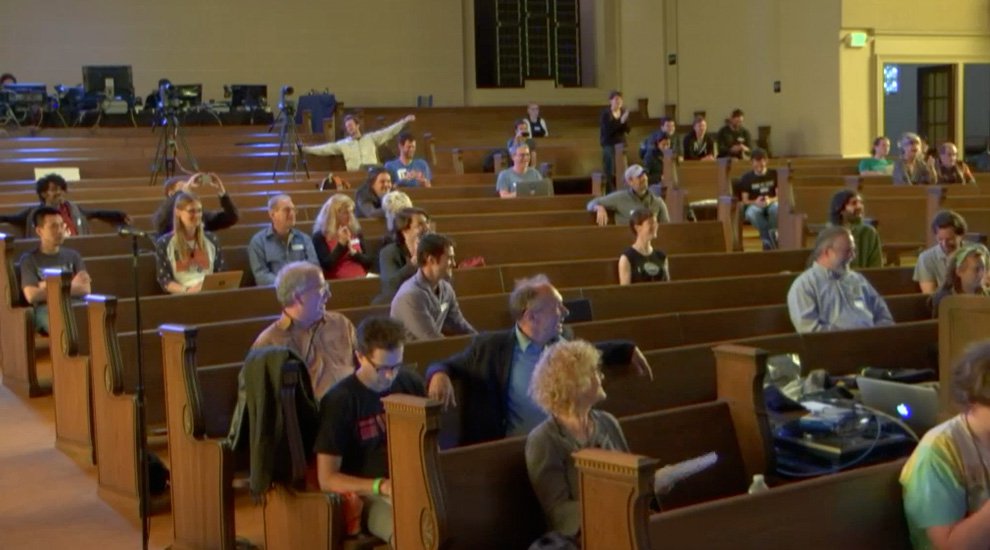Decentralized Web Initiative Aims to Reinvent Web With Peer-To-Peer And Blockchain Technology
The first Decentralized Web Summit, a gathering of developers striving to make the web open, secure and free of censorship by distributing data, processing and hosting across millions of computers around the world, with no centralized control, was held in San Francisco on June 8 and 9.
The Summit was hosted by The Internet Archive, which issued “a call for dreamers and builders … to spark collaboration and take concrete steps to create a better web.” The event was organized by Brewster Kahle, founder of the Internet Archive, and Tim Berners-Lee ‒ the “father of the web” ‒ himself, and attended by top movers and shakers in the computing world, including Vint Cerf, Vice President and Chief Internet Evangelist at Google, and renowned author Cory Doctorow.
The New York Times notes that the first Decentralized Web summit marks the beginning of “a new phase for the web” based on next-generation decentralized systems inspired by the P2P technology that powers file-sharing networks, and the distributed ledger technology ‒ the blockchain ‒ that powers digital currencies such as Bitcoin.
“Edward Snowden showed we’ve inadvertently built the world’s largest surveillance network with the web,” said Kahle. “China can make it impossible for people there to read things, and just a few big service providers are the de facto organizers of your experience. We have the ability to change all that.”
In fact, the internet was designed with a distributed architecture in mind, but today’s web is centralized, with billions of users dependent on a few central services run by large telecom providers and web giants such as Google, Facebook and Amazon. Today’s web is also fragile, because it relies on centralized distribution models, with servers that come and go. If a server goes down for any technical or commercial reason, or is taken down by the authorities, all the web pages stored on that server disappear. But the internet was designed to be much more robust and resilient than that, and the Decentralized Web initiative can be seen as a return to the visionary ‒ and technically more advanced ‒ origins of the internet. Back to the future, indeed.
“The web is already decentralized,” said Berners-Lee. “The problem is the dominance of one search engine, one big social network, one Twitter for microblogging. We don’t have a technology problem; we have a social problem.”
The development of decentralized alternatives to the current web has been ongoing for some years, with projects such as IPFS, the Dat Project, WebTorrent, Tahoe-LAFS, Zcash, ZeroNet, BitTorrent, Ethereum, BigchainDB, Blockstack, Interledger, Mediachain, MaidSafe and Storj. The Summit gathered the developers of these and other projects in a first global session, and it is hoped that the media interest due to the prestige of the main participants will accelerate the development and deployment of decentralized web solutions. The Summit’s website has an information page with current projects, reading material and links to the Decentralized Web discussion groups.
All summit talks, panels and Q&A sessions have been video streamed in real time, and the recorded stream is online at the Internet Archive YouTube channel: Day 1, Day 2.
“I attended the first two days, and the event was inspiring and brilliant,” says Cory Doctorow on BoingBoing. “Speakers included Vint Cerf, one of the inventors of the core internet technologies; and Tim Berners-Lee, who invented the web.” Doctorow notes that the idea for the summit emerged from Kahle’s 2015 series of talks and articles about networks and protocols that are resistant to attempts to capture, monopolize and control them.
The Electronic Frontier Foundation website has a full coverage of the Summit’s first day (morning session, afternoon session), and more coverage is likely to follow soon.
The New York Times article notes that today’s web still runs on relatively old technologies, and online payments are evidence of that. People pay for things online by entering credit card information, not much different from handing a card to a merchant for an imprint. But new payment systems based on distributed ledger technologies could increase individual control over money and permit replacing web ads with micropayment systems.
“Ad revenue is the only model for too many people on the web now,” said Berners-Lee. “Imagine a world where paying for things was easy on both sides.” Internet pioneers such as Ted Nelson, Marc Andreessen and Berners-Lee himself thought that the internet should have a built-in framework for micropayments. Berners-Lee tried to develop a micropayments system for the web through the World Wide Web Consortium (W3C) in the ‘90s, but the idea so far hasn’t been implemented.
Recently the W3C restarted its work on an overall web payments architecture and produced initial drafts, which make only incidental mentions of Bitcoin and distributed ledger technologies. However, digital currencies based on distributed ledgers are the only form of internet-native payment system that exists, works and effectively implements one-click payments.
It is hoped that the Decentralized Web initiative will be able to move faster than the bureaucratized W3C, and implement micropayment systems based on blockchain technology as part of the new, decentralized web. Besides micropayments, distributed ledgers show potential for other aspects of decentralized web technology. See, for example, Bitcoin Magazine’s coverage of Brave, IPFS, Mediachain, Zcash, Zeronet, new distributed social networks and new systems for open science publishing. Of course, many blockchain companies attended the summit.
“We’ve made real progress today,” said Kahle in his closing address at the end of the first day. “Let’s build a decentralized web.”
Photo Internet Archive / YouTube
The post Decentralized Web Initiative Aims to Reinvent Web With Peer-To-Peer And Blockchain Technology appeared first on Bitcoin Magazine.



